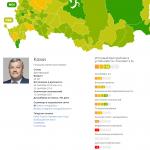Autism Spectrum Disorder (ASD) is a neurobiological developmental disorder that shows signs of a qualitative impairment of social interaction (the Autism Spectrum Analysis Questionnaire - ASSQ can be used to diagnose ASD).
ASD is characterized by core symptoms such as persistent deficits in social communication and social interaction across contexts, and limited repetitive behaviors, interests, or activities. The fundamental phenotype of ASD is a qualitative impairment of social interaction (common clinical view) and, over the past 30 years, various brain imaging studies have been performed, including functional magnetic resonance imaging (fMRI), which can be considered as part of an effort to investigate neural correlates social deficit in ASD.
Among the results of MRI studies that go beyond simply assessing the brain in terms of structure and actually assessing the function of each area of the brain, allowing "to examine in vivo”, one of the most convincingly replicated findings is an anomaly in the so-called “social area of the brain”.
The "social area of the brain" includes the superior temporal sulcus (STS) and its adjacent regions such as the middle temporal gyrus (MTG), fusiform gyrus (FG), amygdala (AMY), medial prefrontal cortex (MPFC), and inferior frontal gyrus ( IFG).
It is known that the "social area of the brain" plays an important role in social cognition, since it is a "reservoir" for the accumulation of cognitive processes necessary for understanding and interacting with other people. In many FMRI studies, a group of ASD patients have been found to show hypoactivation of the "social area of the brain" compared to healthy controls.
To understand the social deficit of ASD (i.e. the clinical features) and to explain the results of brain imaging studies, it is necessary to simplify a number of basic processes of appropriate social interaction between people that are qualitatively deficient in patients with ASD. The first step is to recognize the emotion in the other person's facial expression. The next step is to experience and share the other person's emotional states by imitating and reproducing the identified emotions in one's own mind - the "empathic process". In this regard, the concept of "empathy" can be defined as "an affective state caused by the exchange of emotions or sensory states of another person." The next step after the empathic process is to look at the other person's perspective, understand the underlying situation and the other person's intention that triggered a certain emotion or behavior, and predict and demonstrate appropriate responses. This is called the "mentalizing process" and is essential for successful social interaction.
Neural correlates known to be associated with the key social interaction processes mentioned above (i.e., empathy and mentalization) are included in a region of the social brain that shows an anomaly in imaging studies of patients with autism spectrum disorders. In particular, the perception of an emotional facial expression, which is the first step in understanding the inner world of another person, is a complex visual process that is accompanied by activation of the anterior limbic regions (eg, AMY) and other cortical regions (eg, STS and cingulate cortex), and also activation of FA, which is a selective area and is essential for encoding facial features and recognizing its identity. It is known that STS plays an important role in the visual analysis of dynamic aspects, in particular changes in facial expression. In the next step, in order to empathize with the emotions of another person, it is important to perform the process of modeling the behavior and emotions of another person through the mirror neuron system (MNS). In other words, when we look at another person who is expressing a certain emotion, we go through an internal imitation process through the activation of our MNS, and thus we can feel the emotions that the other person is experiencing "as if we ourselves experienced emotions." These MNS are also included in the IFG area of the social brain area. In addition, mentalization is the ability to understand the intent of another person's behavior and to predict the other person's "mental states". Regions that have been repeatedly identified as neuronal correlates relevant to mentalization based on MRI studies using various paradigms are pSTS/TPJ, temporal fields, and MPFC, which are also included in the "social brain" region.
When emotional facial stimuli are shown to children with autism spectrum disorder (ASD), various areas of the "social brain" related to social cognition show a decrease in their activity. In particular, children with ASD show less activity in the right amygdala (AMY), right superior temporal sulcus (STS), and right inferior frontal gyrus (IFG). Activation of the left insular cortex and right IFG in response to images of happy faces is less in the ASD patient group. Similar results are found in the left superior insular gyrus and the right insula in the case of neutral stimulation.
The deficit of social cognition in ASD can be explained by the impairment of the ability to visually analyze "emotional faces", the subsequent internal imitation through the mirror neuron system (MNS) and the possibility of transferring it to the limbic system for processing transmitted emotions.
Various visual regions (eg, fusiform gyrus, inferior and middle occipital gyrus, lingual gyrus, etc.) are involved in the processing of emotional facial expressions. The results of the studies show that the ASD group does not show reduced activation of these visual areas compared to the control group, and when stimulated with a happy face image, the ASD group shows quite increased Rt activation. in the occipital gyrus compared with the control group. This can be interpreted as indicating that while visual perception and analysis are essential for successful social interaction, downstream processes such as internal imitation, emotional processing, and interpretation of the intentions of another person's behavior are critical.
The insular cortex region plays a role in connecting with the limbic system (i.e. "emotional center") and is required in order to feel another person's emotions as if it were one's own emotion, through internal imitation occurring in the MNS. Anatomically, the insular region is associated with both the MNS and the limbic system (for happy and neutral facial imaging stimuli, the ASD patient group shows reduced activation of the insular region.
According to the "Right Hemisphere Hypothesis", the two hemispheres of the brain are specialized differently in relation to emotion processing. In other words, the right hemisphere is uniquely qualified to process emotions, while the left hemisphere plays a supporting role in emotional processing. It also seems that emotion-related tasks are shared between the two hemispheres of the brain, with the right hemisphere specialized in perceiving negative or avoidant associated emotions, while the left hemisphere is activated by emotions from positive experiences.

US researchers believe that by scanning the brains of infants who have older siblings with autism, it is possible to make a fairly accurate prediction of whether the children under study will also develop autism or not.
The results of a recent study give scientists hope that there is a very real possibility of diagnosing children with autism spectrum disorder (ASD) even before they show the first symptoms. Previously, this goal seemed unattainable.
Moreover, the study opens up possibilities and perspectives in the diagnosis and possibly even treatment of autism.
But first, let's figure out why it is so difficult to diagnose autism in children. Typically, a child will show symptoms of an autism spectrum disorder (such as difficulty making eye contact) after the age of two. Experts believe that the brain changes associated with ASD begin much earlier—perhaps even in the womb.
But various methods that measure human behavior cannot predict who will be diagnosed with autism, says study lead author Joseph Piven, a psychiatrist at the University of North Carolina at Chapel Hill.
“Children who show signs of autism at the age of two or three do not look like they have autism in their first year of life,” Piven explains.
Many wonder if there are any genetic "signatures" or biomarkers that could help predict the development of autism. It is noted that there are some rare mutations associated with autism spectrum disorder, but the vast majority of cases cannot be associated with one or even more genetic risk factors.

Back in the early 1990s, Piven and other researchers noticed that children with autism tend to have slightly larger brains than their peers. This suggested that brain growth might be a biomarker for autism spectrum disorder. But Piven and colleague Heather Cody Hatzlett, a psychologist at the University of North Carolina at Chapel Hill, note that it's not at all clear exactly when such overgrowth occurs.
Statistically, autism occurs in about one in 100 children in the general population. But babies who have older siblings with autism run a big risk: a 1 in 5 chance of developing ASD.
As part of the NIH-funded Infant Brain Imaging Study, Piven and colleagues scanned the brains of 106 high-risk children. The age of the babies at the time of the study was 6, 12 or 24 months.
Experts used magnetic resonance imaging (MRI) to see if they could "catch" what they call brain growth in action. In addition, they studied 42 low-risk children.
15 high-risk children were diagnosed with autism at 24 months of age. MRI scans showed that the brain volume of these children increased faster between 12 and 24 months compared to children who had not been given a similar diagnosis. The researchers say that this increase occurred at the same time that the behavioral signs of autism appeared.
The researchers also found brain changes at 6 and 12 months of age, before the onset of ASD symptoms. Cortical surface area - a measure of the size of the folds on the outside of the brain - grew faster in infants who were later diagnosed with autism. Again, compared with those children who were not given a similar diagnosis.

Perhaps the main question arises: is it possible to focus on these brain changes and use them to predict autism in children? A group of scientists led by Hatzlett and Piven further entered the MRI scan data (changes in brain volume, surface area and cortical thickness at the age of 6 and 12 months), as well as the sex of children into a special computer program. The goal is to find out which babies at 24 months of age are most likely to have autism.
It turned out that brain changes recorded at 6 and 12 months (among children who have older brothers and sisters with autism) helped to successfully identify 80 percent of all babies who were diagnosed with ASD at the age of 24 months.
In other words, the researchers were able to correctly identify which infants were diagnosed with autism at two years of age 80 percent of the time.
The authors clarify that their results still need to be confirmed in further research work and with a large number of newborns from the high-risk group. In addition, they intend to use other imaging techniques to help detect early brain changes.
Other experts point out that, even if the results are reliable, the clinical application of such a technique may be quite limited. Specialist Cynthia Schumann of the University of California, Davis, says the findings apply only to high-risk infants and not to the general population. She notes that other studies will be needed to test whether it is possible to predict the development of autism in children not at risk.
From a medical point of view, autism is a complex medical condition with an unclear etiology (i.e. causes). In my practice, I try to learn as much as possible about each of my patients. This requires a thorough examination of the child himself, detailed communication with parents about the medical history, as well as extensive laboratory tests.
Here's where I start my research:
- The actual admission of the patient: The standard ten minutes that the pediatrician graciously grants to the patient is not enough here. Among other things, the conversation should include a detailed description of the drugs taken during pregnancy, a description of the food the child takes, and a story about older relatives: do grandparents and older parents have any quirks?
- Audiology: I had a patient from Canada who had no hearing test. The boy was deaf, but not autistic.
- MRI: I'm not a big fan of this procedure. First of all, you need to take into account the risks that general anesthesia creates (without it, this study will not work, since complete immobility of the child is required). The main practical value of MRI often comes down to the fact that parents cheer up a little: according to external signs, everything is in order with the brain.
- EEG: often the child does not show any visible epileptic seizures (loss of consciousness or muscle twitching). However, prominent autism doctors believe that checking brain rhythms (especially if it is also performed during sleep) can be of great importance in identifying peaks in activity that can harm the brain.
And now the fun begins: you need to somehow convince the child to cooperate with you during the procedure. Then you need to find a good pediatric neurologist who will help decipher the data. The next step is to decide whether to treat the areas of increased electrical excitability, since no anticonvulsant drug is completely safe. A very difficult and time-consuming process. - Detailed blood test: very often pediatricians ignore this simple test. If we are striving to ensure that the brain is sufficiently saturated with oxygen, we first need to understand whether the child is suffering from anemia.

- Assessment of lead and mercury levels in the patient's blood: the theory that heavy metals can somehow be “locked up” in the brain is controversial and has been the subject of much debate in the medical community. But such a check often helps to calm worried parents. I oppose the introduction of a special provocateur into the body, which will make heavy metals stand out, without first finding out their baseline.
- Other metals: magnesium, calcium and zinc are very important for many chemical reactions taking place in the body. Picky eaters often miss out on essential nutrients. Micronutrient deficiencies can lead to skin rashes and digestive problems.
- Assessment of the thyroid gland: I offer you a logical construction. We have a patient who demonstrates hyperactivity or, conversely, lethargy and loss of energy. How can we know that this condition is not related to thyroid health if we don't get it checked? Correct answer: none.
- Chromosomal analysis: conventional doctors too often tell parents that autism is a genetic disease and that it is useless to treat it in any way other than classes like ABA. So why not check the chromosomes themselves? If they are all right (at least to the extent that modern genetics can claim it), then obviously biomedical intervention has a much better chance of success than is commonly believed.
- Gastrointestinal health: I prefer to see a detailed coprogram and check feces for dysbacteriosis in order to know for sure if there is a pathological overgrowth of pathogenic microorganisms (including yeast fungi) in the intestines, and how the process of digesting proteins, fats and carbohydrates is going. By the way, it will be much easier to potty train a child when intestinal health is restored.
- Food allergies: when the body reacts to an agent coming from the external environment by secreting immunoglobulins, an inflammatory process takes place, which undermines the overall energy of the body. Avoiding foods that are known to be hypersensitive will help clear the haze and improve eye contact and communication.
A gluten-free, casein-free diet usually doesn't work in two ways: 1) The patient is not allergic to either gluten or casein; 2) The child continues to receive some third (fourth, fifth ...) product to which he has an allergic reaction.
We check children sensitivity to a very wide range of foods and we advise not some general diet, but a diet specially selected for a particular patient. It is also necessary to test urine for traces of substances like opiates, which are associated with poor absorption of gluten and casein in the intestine. - Vitamin levels: it is especially important to know if the patient is getting enough vitamins A and D from food. This is easy to find out and just as easy to solve with multivitamin supplements.
- Knowledge about metabolism: information about how well a patient's kidneys and liver are working should be familiar to the attending physician, as this determines the tolerability of many medications.
- Lipid panel: both high and low cholesterol levels can lead to health problems. If cholesterol is very low, it is easily corrected with medication, often leading to improvements in eye contact and communication. Also, this information can affect the composition of the diet used.
Autism is characterized by difficulty in communication and speech disorders. Researchers from Columbia University (USA) have proposed a method for diagnosing this mental disorder at an early stage - using an MRI analysis of the activity of the speech analyzer in the brain.
Brain tomogram when performing an audio test; red indicates the most active areas, among which the auditory temporal lobes stand out. (Photo by Montreal Neurological Institute.)
Statistically, autism and related mental disorders at least one child out of 110 suffers, but there are still no clear diagnostic criteria that would make it possible to detect this disease in the early stages. The diagnosis is made by external manifestations, of which there are a great many in autism spectrum disorders. Researchers from Columbia University in New York have proposed their own method for the unambiguous diagnosis of autism, based on the use of functional MRI.
One of characteristic features of autistic disorders is the difficulty in communication, which sooner or later manifests itself in the child; such children rarely and poorly speak, and often do not seem to hear what others say to them. The study involved 15 healthy children and 12 with speech disorders and clear signs of autism; on average, all subjects were slightly older than 12 years. During a brain scan using a tomograph, they were allowed to listen to a recording with the speech of their parents, who seemed to be talking to them.
In healthy subjects, in response to parental speech, increased activity of two areas of the brain- the primary auditory cortex and the superior temporal gyrus, which is responsible for understanding a sentence as an interconnected sequence of words. At autistic children the activity of the primary auditory cortex was the same as in healthy subjects, but the activity of the superior temporal gyrus was significantly lower. In other words, autistic people with speech disorders do not literally understand what they are being told, the sentence is heard by them as a set of unrelated words. Just as different brain activity in healthy and autistic children after taking sedative drugs: despite the effect of sedative drugs, the “language-understanding” gyrus worked differently in both groups.
An article by researchers with the results of the experiments is being prepared for publication in the journal Radiology.
Autism Spectrum Disorders amenable to therapy, but the key to success here is early detection of the disease. Perhaps the proposed method will greatly facilitate the diagnosis of autism at the key, early stages of its development.





